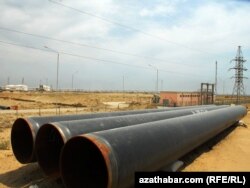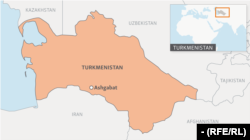February 23 was a great day for Turkmenistan and its neighbor to the south, Afghanistan. Turkmen President Gurbanguly Berdymukhammedov joined Afghan President Ashraf Ghani, Pakistani Prime Minister Shahid Khaqan Abbasi, and Indian Minister of State for External Affairs M.J. Akbar in the Turkmen border town of Serhetabat, where a segment of a pipeline coming from Turkmenistan was welded to a segment coming from Afghanistan.
It was a big day for Turkmenistan for another reason, too.
"We have concluded our work in Turkmenistan and we now move to Afghanistan," Muhammetmyrad Amanov, the CEO of the TAPI Pipeline Company, said in a February 28 Euronews report. "We plan to finish the job and put gas in the pipeline towards the end of 2019."
From the early years after Turkmenistan's independence in 1991, officials there, beginning with the president at the time, have been prone to offering optimistic or flattering appraisals of the country's achievements. Later evidence showed some of these claims were exaggerated or just plain false.
So how to understand the news from a Turkmen state news agency on November 19 that Saudi Arabia's Global Pipe Company had started delivering pipeline segments to Turkmenistan for constructing the TAPI pipeline?
According to the state news agency of Turkmenistan (TDH), 175 train wagons carrying some 4,956 meters of pipe had reached the train station at Ymambaba in Mary Province; under the contract with the Saudi company, 35,000 meters in total would be delivered in two stages, at a cost of some $40 million.
The pro-government website Orient made clear in its report the same day that "steel pipes are immediately transported to construction sites for assembly."
Turkmenistan started construction of its roughly 200-kilometer section of the approximately 1,800-kilometer TAPI pipeline on December 13, 2015. And, according to Amanov in his Euronews interview, at the end of February of this year the Turkmen segment was done.
There was never any mention in TDH or Orient of why 35 kilometers of pipeline were still needed for a pipeline that was announced as being completed eight months ago. While there could have been some damaged segments somewhere, the length of pipeline needed -- more than 15 percent of Turkmenistan's total section of TAPI -- suggests there never was any pipeline in at least part of the country.
Dubious Claims
There has been a good deal of skepticism about TAPI construction on Turkmen territory since the authorities there announced the launch of construction in December 2015. Turkmen state media have always been eager to show the feats of the government: the Awaza resort area with its white marble five-star hotels; the "Olympic Village" in Ashgabat, built for the Asian Indoor and Martial Arts Games the country hosted in September 2017; even the massive sculpture in Ashgabat of President Berdymukhammedov on horseback. These and more have all been shown on state television.
So it seemed strange that the only photographic evidence Turkmen media ever provided of TAPI was still photographs of unassembled segments of pipe in the desert, which could just as easily have been from construction of the East-West gas pipeline that was completed in 2015 or part of earlier pipelines running from Turkmenistan to China, or from Turkmenistan to Iran.
Before leaving TAPI and looking at some of the other dubious claims to have emerged from Turkmen officials, it is worth mentioning the estimated launch date and cost of TAPI.
Amanov said on Euronews that gas would start flowing into the pipeline before the end of 2019. Not very far, apparently, since Pakistan is planning on launching construction of its approximately 780-kilometer section of TAPI sometime early next year and it would be complete sometime in 2020. And there has been no report of TAPI construction on Afghan territory since the February ceremony, though there have been many reports of fighting in the northern Afghan provinces bordering Turkmenistan since then, and in other areas of Afghanistan along the proposed TAPI route.
The cost of TAPI has been revised...downward. At a November 13 International Gas and Oil conference in Abu Dhabi, CEO of the TAPI Pipeline Company Amanov told the audience that TAPI would cost $7 billion, substantially lower than the often-cited high estimate of $10 billion. There was no explanation of how TAPI is suddenly set to come in under budget. Plans still call for the 1,800-kilometer pipeline to ship 33 billion cubic meters of gas and the same material and labor force will still be required.
One explanation could be that the operating company for the project is Turkmengaz, which has no experience building a pipeline outside Turkmenistan and has had little success attracting investors for TAPI, might be shaving 20 to 30 percent off the estimated cost to add an extra incentive to lure financiers for the project.
Food Shortages?
The abundance of goods in stores in Turkmenistan is another interesting story that Turkmen media have been keen to cover lately. State media reports about food on the shelves were rarely, if ever, aired or printed before, when there was food in stores. But during 2018, Turkmen state television has shown the variety of goods available to the population.
These reports come as information has been leaking out for more than two years of shortages of basic goods in Turkmenistan. People are lining up out into the streets to get bread, flour, cooking oil, and sugar, all of which are rationed and all of which sell out quickly when they become available.
A video posted on November 28 by the Europe-based Turkmen opposition website Khronika Turkmenistana shows people in the capital, Ashgabat, waiting near a store for the bread truck to arrive. There is a limit of two "churek," the round flatbread of the region, and the video shows two loaves are the most anyone is carrying as they exit the store.
It is not only opposition websites that are reporting on shortages of basic goods in Turkmenistan. Uzbek television and Kyrgyzstan's AKIpress have reported about it, too.
The stores seen in Turkmen state media reports do exist. They all seem to be in Ashgabat, but even when state media show them, there are few, if any, customers in the stores. It seems clear enough that these markets are not open to everyone.
Curiously, these reports seem designed for an audience outside Turkmenistan, since the population of the country, many of whom are queuing up for things like bread, are surely aware the selection of products shown on television is not available to them.
As noted at the beginning of this report, such obfuscation is not new to Turkmenistan.
Turkmenistan's first postindependence president, Saparmurat Niyazov, deserves credit for starting Turkmenistan down the road of incredulous information. After Niyazov underwent multiple-bypass heart surgery in September 1997, he started making some interesting pronouncements. He said the Turkmen people could trace their history back some 8,000 years and that Turkmen people were the first people to develop a democratic system of government.
Niyazov was displeased with the results of grain and harvests in the first years of Turkmenistan's independence and took to sacking and humiliating officials who failed to meet the often-unrealistic targets that Niyazov set. During the drought of 1999-2000, for example, he told farmers he was tired of their excuses for not meeting quotas and did not want to hear any more stories about lack of water causing harvest shortfalls. The grain harvest for 1996 was 480,000 tons. The grain harvest for 2006, the year Niyazov died, was reported to be 3.5 million tons. Turkmenistan's parliament gave Niyazov a series of medals and awards as the grain harvest increased year by year.
The reported grain harvest after Berdymukhammedov came to power was some 1 million tons, though it increased to about 1.5 million tons by 2011. Turkmen authorities reported the grain harvest was some 1.6 million tons in 2018, but authorities never commented on why Turkmenistan was forced to buy some 100,000 tons of grain from Kazakhstan in 2018 for the first time in many years.
In April 1995, Turkmenistan released the results of its census, showing 4,000,460 people lived in the country. By March 2006, Turkmenistan's National Statistics Institute reported the population was some 6.786 million, a nearly-75 percent increase in 11 years.
Turkmenistan never released the results of its 2009 census, but the population is currently estimated to be some 5 million people.
The construction of TAPI is the latest tale from Turkmenistan that has been cast into doubt, but it is far from the first.











